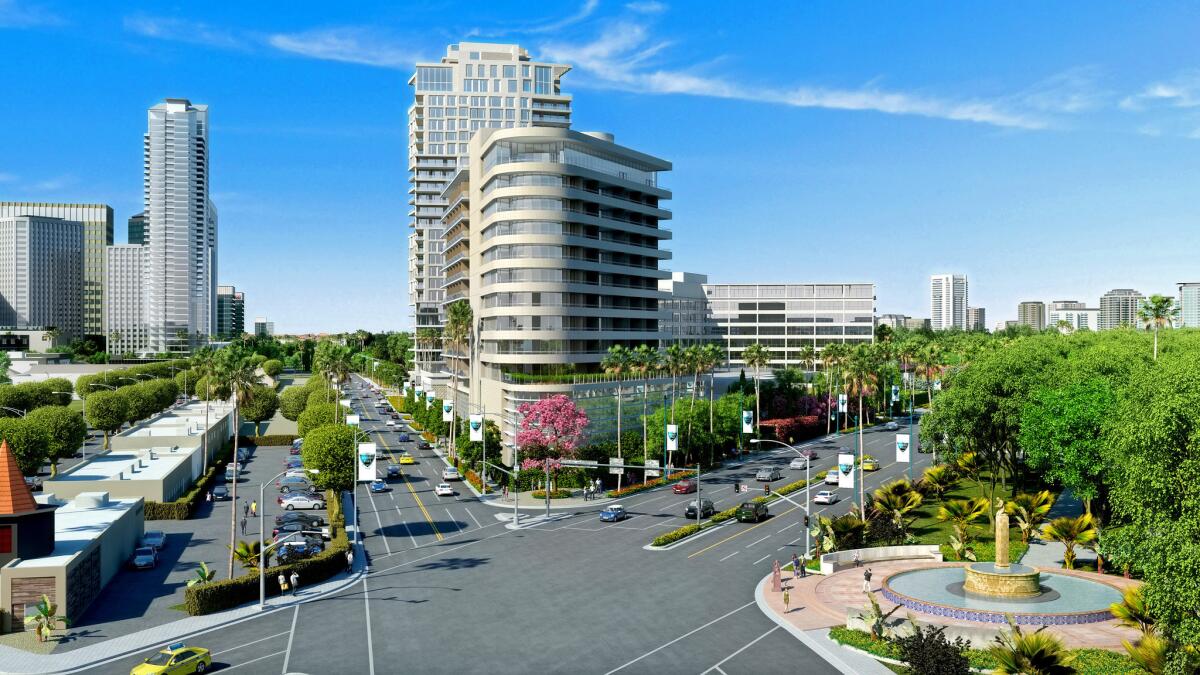Beverly Hilton owner wants voters to approve 26-story condo tower

- Share via
Last decade, real estate investor Beny Alagem narrowly secured voter approval to construct not only a Waldorf Astoria hotel next to the Beverly Hilton, but also two condo towers -- including an 18-story building that would be the tallest in Beverly Hills.
The referendum proved a significant victory for Alagem in the development-wary city, but it also was contentious, with some opponents making allegations of voter fraud that were never proven.
Now, the owner of the Beverly Hilton is back to take on his opponents again, and this time he wants to go even higher. He’s campaigning to pack all his planned 110 condos into a single 26-story high-rise, and isn’t pinching pennies to get his way.
Alagem and his affiliated companies have so far spent more than $1.2 million, city records show, on attorneys, public relations firms, advertising and other services to place an initiative on the November ballot.
Passage would avoid additional city review that could drag on for years.
The developer is pitching his proposal as a way to give Beverly Hills needed green space. Without the second building, he will have room to put in a 1.7-acre park that will serve as a gateway to the wealthy community near its border with Century City.
Plans include fountains, walking paths, art sculptures and a rose garden. A restaurant would look out upon the park, similar to the upscale Tavern on the Green in New York City’s Central Park.
“The whole entry into Beverly Hills will all have these green, beautiful exotic gardens,” said Alagem, 63, who is currently overseeing construction on the 170-room Waldorf Astoria. “It will be a very elegant place for people to come to gather and enjoy this urban oasis.”
Part of the impetus, of course, is economic.
By changing the plans, Alagem said that not only would Beverly Hills residents gain a new park, but so would condo buyers and guests of the Hilton and Waldorf Astoria -- making the entire project more attractive and probably more profitable.
“It’s better for the community and better for us,” he said.
Supporters of the Beverly Hills Garden & Open Space Initiative backed by Alagem submitted more than 7,000 signatures this month. The county has until early June to verify that at least 2,110 of those are valid.
Just like last time, Alagem’s Oasis West Realty is facing a backlash in a city that prides itself as being almost a small town in a huge metropolitan area. Critics have taken particular aim at Alagem’s move to put the decision directly before voters.
Mayor John Mirisch said passage of the initiative would hand the developer a more valuable project while allowing him to bypass studies to determine if the high-rise would worsen traffic, or create odd shade and shadow problems because of its height. He also worries that the project might attract more events.
“They are calling it the open space and garden initiative, when really it is an initiative to build a 375-foot skyscraper,” he said. “A 375-foot building in our city would absolutely be unprecedented.”
Alagem’s proposal probably would have taken about 12 to 18 months to process, including additional analysis under the California Environmental Quality Act and review by the Planning Commission and City Council, according to city staff.
Independent land use experts put the time frame at even longer.
“Bypassing the city and taking the issue straight to the voters could save two to three years,” said land use consultant Kate Bartolo, who is not involved in the Hilton proposal.
Alagem believes further studies are unnecessary, because he isn’t adding additional uses, event space or housing units that would generate more traffic. He also contends that the 26-story tower would blend in with larger buildings just over the border in Century City.
Still, moving fast on such a luxurious project could have its own benefits given signs that the ultra-high-end market is sputtering across the country.
Sales, for example, have slowed at marquee Manhattan condo towers that have units priced in the tens of millions of dollars. The luxury market has cooled to a lesser extent in Los Angeles, in part because developers haven’t flooded the market like they have in New York.
They are calling it the open space and garden initiative, when really it is an initiative to build a 375-foot skyscraper.
— Mayor John Mirisch
More is coming though. A 59-unit Four Seasons-branded complex in Los Angeles is set to open on the edge of Beverly Hills next year and Chinese Developer Wanda Group is looking to build a hotel and 193 condos across from Alagem’s project.
“You don’t want to miss the cycle,” said Larry Kosmont, an L.A.-area urban development consultant. “We are probably midway to the end of a pretty robust real estate cycle, so every date counts.”
Alagem said a slowdown is “always a concern.” He added that he’s not focused on today’s market, but rather on “creating the best plan for the property and the community in the future.”
“One thing is certain in my opinion: We are going to create a very, very special building that in Beverly Hills today does not exist in a very large way,” he said.
Alagem envisions a top-of-the-market luxury condo building, clad in Portuguese limestone, with a private fitness center and spa. Residents would enjoy concierge service from the Waldorf Astoria, which is expected to open next year. High rollers could have their shopping done, fridges stocked and concert tickets ordered and delivered.
The project, including the Waldorf Astoria, is expected to cost $700 million by the time it’s complete. The condo prices, though not yet precisely set, will reflect that.
Alagem said that the top of the condo market in Los Angeles is currently around $2,000 a square foot, which translates to $6 million for a 3,000-square-foot condo -- expected to be the project’s average-sized unit.
Perhaps not surprising in a city where development is closely scrutinized, even his planned park has become an issue of contention.
The initiative states the privately owned park “shall generally be open to the public, hotel guests, event guests and residents.” Access, including hours, will be determined by Oasis and the “garden and open space may be used for private events from time to time.”
Some residents have expressed concern they would be stuck with an out-of-character tower while not getting a truly public park.
“The so-called green space or garden is really under control of the Hilton,” said Thomas White, chairman of the Municipal League of Beverly Hills, a residents organization.
Alagem counters that it would be open “all day long,” and only a small portion would be closed at times for private events. (Large events, such as the Golden Globes, though, probably would require the entire park to shutter for security reasons, he said.)
“I am not building a park to not make it accessible to people,” said Alagem, adding that if he wins approval he would record some sort of document to ensure nothing could be built there in the future. “This is a garden that will remain here forever.”
Born in Israel, Alagem co-founded Packard Bell Electronics in 1986 -- making him a wealthy man before he resigned as chief executive of the computer maker in 1998 after clashing with major shareholders.
In 2003, his Oasis West paid $130 million to entertainer Merv Griffin for the Hilton, which by then had lost some of its allure. Since then, Alagem has plowed in an additional $100 million to restore the hotel, including room and ballroom renovations.
In 2008, he gained voter approval to build the condos and the Waldorf Astoria, after angry residents succeeded in putting the council’s previous approval up for a referendum. When the project is completed, the property will total 47 fewer hotel rooms than when Alagem purchased it because a portion of the Hilton will be razed for the condos.
Not all Beverly Hills residents have concerns over Alagem’s latest pitch.
Martin Geimer, a longtime resident and former city Recreation and Parks commissioner, said the new plan with a park is a better alternative than the first proposal.
“It may be closed from time to time, but it’s still 100% green space, versus 100% building,” said Geimer, who added that he voluntarily helped collect signatures to get the proposal on the ballot.
Alagem said he plans to start construction on the condo units, either as one building or two, a year after voters decide.
Still, if the 2008 election is any guide, the controversy may not be ended by the vote.
After the referendum narrowly passed by 129 votes, opponents contended they discovered more than 550 instances of voting irregularities.
Alagem called such claims “nonsense.” A spokeswoman for the Los Angeles County district attorney office said the complaint was reviewed and the office found “there was insufficient evidence to file any charges.”
ALSO
CBRE sells downtown headquarters for $330 million
McLaren builds a car for the masses, with a $200,000 price tag
Who’s got the most cash in corporate America? For the first time, 5 tech firms
Follow me @khouriandrew on Twitter
More to Read
Inside the business of entertainment
The Wide Shot brings you news, analysis and insights on everything from streaming wars to production — and what it all means for the future.
You may occasionally receive promotional content from the Los Angeles Times.










